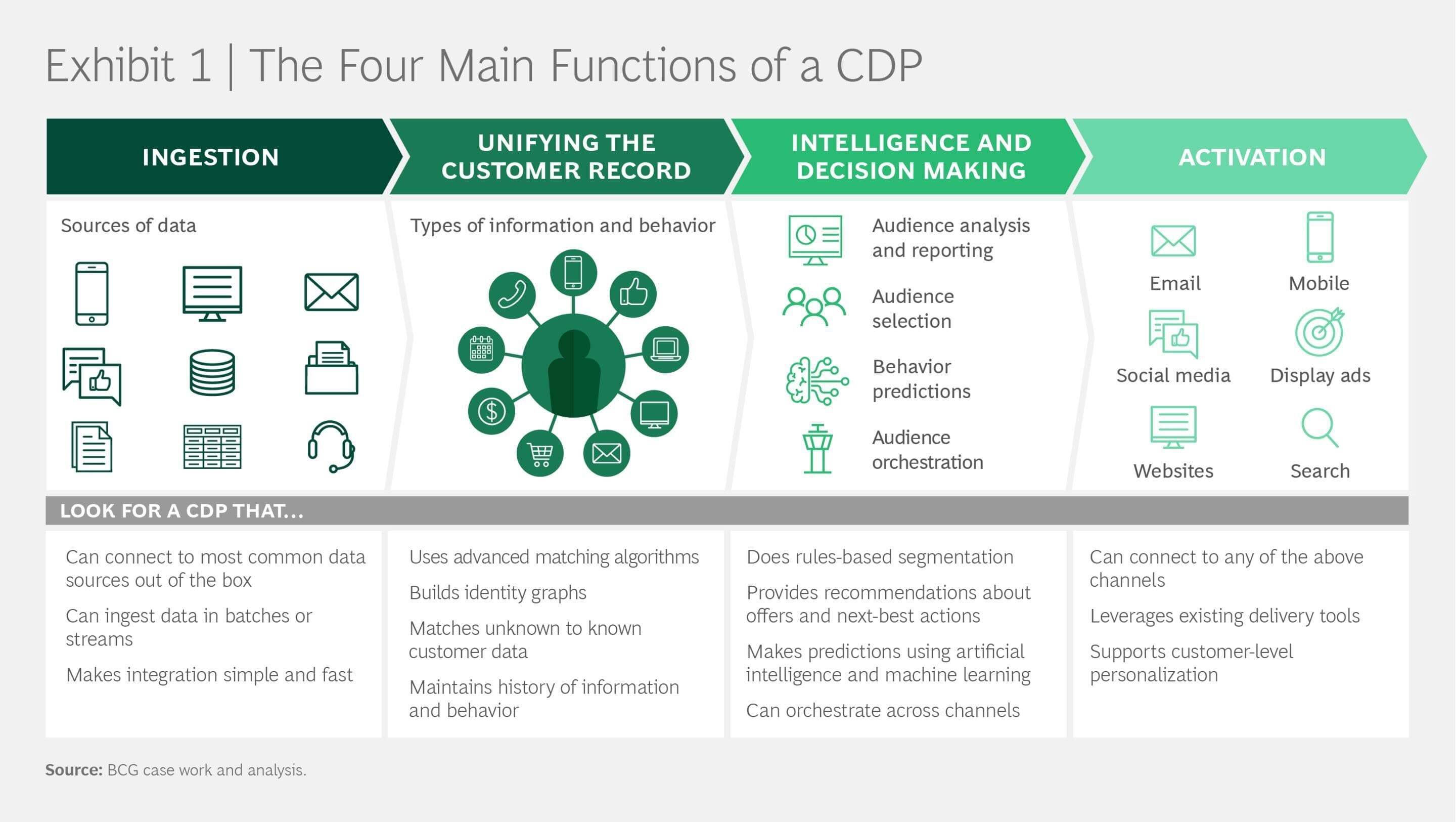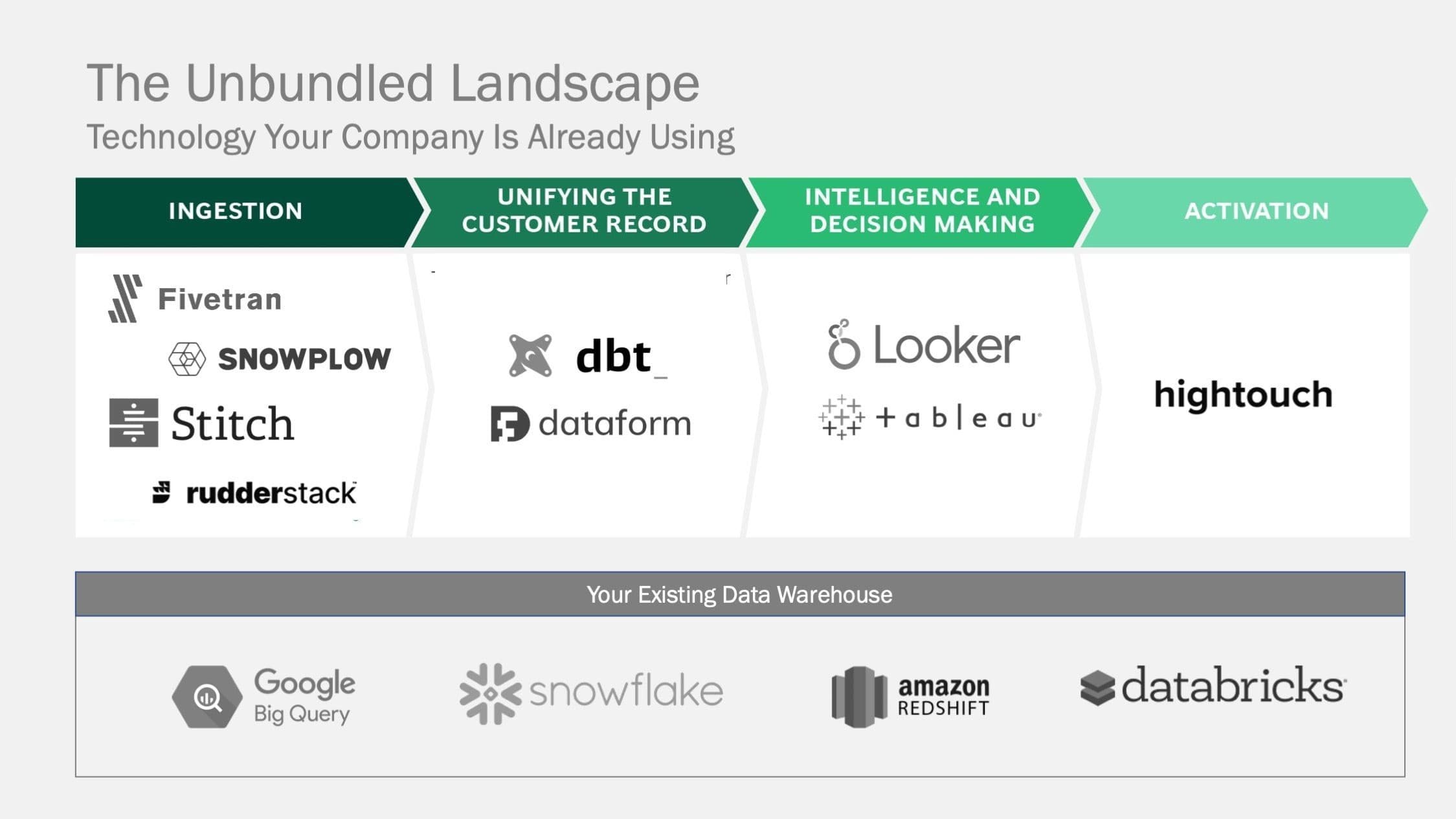This article first appeared on LinkedIn and later on CMS Wire.
A first-party customer data platform is essential for businesses now more than ever. Anonymous customer identifiers — Cookies and Device IDs — are disappearing, and a first-party data strategy is critical for companies to reach and engage customers.
Until recently, the only way to achieve this vision was to implement a Customer Data Platform. When fully implemented and adopted by all teams within a company, a enterprise CDP provides much value to a businesses' bottom line.
Unfortunately, not all Customer Data Platforms (CDPs) are fully implemented and adopted by the teams they are intended to serve. The CDP Institute’s latest survey found that just “23% of consumer marketers have completed their projects on time and on schedule, and only 58% of companies with a deployed CDP say it is delivering significant value.”
Even when fully implemented, CDPs introduce new and often redundant work to organizations where people and resources are already taxed with other pressing full-time responsibilities. More modular approaches to customer data management are emerging in this context, and this "unbundled" approach better aligns with existing internal processes. Better alignment means less work, less redundancy, and more adoption by the company at large.
Traditional CDP vs. Composable CDP
See how the two approaches compare across speed, compliance, cost, and scale—all in one chart.


The Bundled Components of a CDP
To understand what is being unbundled, let's break down what services are provided by a CDP. A CDP vendor provides both a database and software to perform these four functions.
- Ingestion: collecting events on your customers from every Martech system in use
- Unifying The Customer Record: create a single source of truth for the customer; their profile and interaction history
- Intelligence and Decision Making: analyze for cohorts and conversion and segment customers in audiences
- Activation: Push enriched profiles and segments to marketing channels
Boston Consulting Group published an article, “With Customer Data Platforms, One-to-One Personalization Is Within Reach,” including this slide which visualizes the four functions well.

The first two functions - ingestion and unification - result in a data warehouse containing a 360-degree view of the customer that can support any number of business scenarios:
- Product data - actions they've taken within your application (like what items have been viewed or left abandoned in their shopping cart)
- Sales data - where a customer is in their buying journey
- Marketing data - what blog posts they've read, how they first landed on your site, etc.
The third and fourth functions - analysis and activation - turn data into action by segmenting consumers who can be activated through the appropriate channels - email, SMS, CRM, advertising, and on-page personalization.
Note: As defined by the CDP Institute, only items 1 and 2, Ingestion and Unifying the Customer Record, need to be present to be considered a CDP. However, most CDP vendors provide Intelligence and Activation capabilities as part of an end-to-end solution for customers.
An Unbundled CDP Sits On Your Company’s Data Warehouse
Unbundling simply means a business has chosen to create a CDP utilizing its data warehouse by assembling the four functional components independently of a single vendor.
Why Marketers Should Care About The Data Warehouse
Understandably most marketers don’t care about the specifics of database technology, they simply want to use customer data to drive more targeted engagement and sales over their respective channels.
Using an internal data warehouse benefits marketers by tapping into the growing data and people resources within other parts of the organization. In the last few years, companies have moved their legacy systems onto a modern data stack. And in the process have already integrated the same systems as a CDP. In addition, the BI team has staffed up with analysts and data scientists to mine the data for better business insights.
These internal resources can deliver far more than reports; they can enable marketing teams with richer, directly actionable data about their customers directly to all activation channels - email, advertising, eCommerce, and B2B CRM systems.
My Experience at Universal Music Group
I witnessed these industry trends first hand in 2019 while working at Universal Music Group (UMG). I led the implementation of leading CDP in conjunction with the migration from multiple Email Service Providers (ESP) to a single Cross Channel Marketing Platform (CCMP)
Unfortunately, the CDP went unutilized for reporting and activation by the respective BI and marketing teams post-deployment. Here I’d like to share key lessons learned that apply to anyone implementing a CDP. In the process, I hope to illustrate the benefits of using the internal warehouse and teams for the organization overall.
Direct Marketing Ecosystem and Need for a CDP
UMG is a global music company with heterogeneous technologies and autonomous teams arrayed across the globe. Digital touch-points number in the thousands as marketing occurs through separate artist sites, stores, and email lists.
In aggregate, Universal Music Group had millions of first-party data points about their consumers, but the complex technical environment made it impossible to answer basic questions like:
- How big is the combined and deduplicated audience?
- How can we identify and engage with the biggest fans of our artists?
A CDP seemed the ideal solution to answer these questions and much more.
We implemented our CDP over six months integrating multiple CMS, ECOM, ESP systems. However, post-launch, both reporting and activation teams failed to adopt and utilize these new capabilities.
Traditional CDP vs. Composable CDP: Which Fits Your Data Strategy?
Cut through the noise with our side-by-side guide. See exactly how traditional CDPs stack up against Composable CDPs across cost, speed, compliance, and flexibility.
- Faster time-to-value: Why Composable CDPs launch in weeks, not months
- Complete flexibility: Compare schema limits vs. support for any data model
- Better compliance: GDPR, CCPA, and HIPAA readiness at a glance
- Cost transparency: Bundled MTU pricing vs. unbundled features
- Built for scale: How Composable CDPs enable advanced personalization
Get the guide and decide if it’s time to modernize your CDP strategy.


Barriers to Adoption and Lessons Learned
I spent time with marketing and data teams and heard three common complaints.
“I Don’t Have Time to Use the CDP”
I often heard this from Marketing teams whose activation flows now required extra steps due to the newly implemented CDP. Audience segmentation was historically handled in activation channel tools — advertising, email, on-page personalization, and now the teams had to use an upstream tool to build audiences and segments.
Lesson Learned: Bring the Data to Existing Tools First
In a decentralized environment, changing marketing tools is not a trivial undertaking. A better first step is to push data to existing point solutions (like Braze and Salesforce Marketing Cloud). Then, teams can migrate to more powerful tools and processes as the company matures its data practices.
“I Don’t Trust the Data in the CDP”
I often heard this from the data and BI teams who didn't trust the CDP's profile unification model, as off-the-shelf CDPs are a black box in terms of modeling. The BI team was tasked with reporting on the total first-party audience using the deduplicated and unified set data captured within the CDP database. In our case, both the CDP and the BI team used Google BigQuery, so data syncs happened in real-time between the two databases. Unfortunately, once the BI team started working with the data, they questioned the unification model so much so that they re-ingested the same data sources like ESP to build their own model.
Lesson Learned: Don’t Underestimate Reporting Needs
In the Martech world, each point solution provides its reporting dashboard. As data is consolidated into a CDP, BI teams want to mine this data for new insights. CDPs provide their reporting dashboards, but as with many embedded reporting, they don't offer the level of control and customization dedicated data teams expect.
“I Prefer My Current Workflow Over the CDPs Workflow”
I heard this from both data and marketing teams. In most cases, the internal teams were already performing the critical functions, albeit with different tools and technology.
- Data Science and BI teams were already ingesting, normalizing, and analyzing data designed to produce insights and reports for the business.
- Marketing teams analyzed, segmented, and activated audiences, albeit from a much smaller data set.
Lesson Learned: Avoid Redundancy or Staff Accordingly
Unlike other marketing technologies, CDPs provide overlapping functionality to many of the existing tools within the organization. Assigning operational responsibility for the new CDP functionality to existing practitioners underestimates the amount of new work asked of teams.
To be successful, companies will either need to integrate new data workflows into existing tools or add additional staff dedicated to managing the CDP application-specific processes.
Unbundling and More Agile Approaches Are Emerging
Failure to launch a CDP does not remove the original business drivers. A first-party data solution continues to drive the CDP category even if it means multiple attempts to "get it right".

Fortunately, a more agile and modular approach is emerging, allowing businesses to add CDP functionality to their existing teams and resources. In effect, all the elements making up a SaaS CDP can now be decoupled from a single vendor and implemented by the appropriate sections within a business in a more modular fashion.
Better still, the CDP vendors are opening up their products to support improved interoperability and a la carte implementation of their components.
More Iteration Than Transformation
Decoupling components functionally frees a company up to iterate from its current digital state rather than undergoing a significant digital transformation process.
For example, using a Reverse ETL solution to sync customer data from a data warehouse to a marketing tool is an easy-to-implement solution for activation. Marketers can keep working in their existing tool but with an enriched data set.
Contrast this approach with the heavy lift of deploying a CDP from scratch, where all systems need to be integrated into a new database (typically 3-6 months minimum) before the marketing team can start activating data.
To be fair, an unbundled approach requires a company to be mature and manage its data warehouse, but that is where businesses find themselves today. In those instances, it doesn't make sense to rebuild those same connections on an external stack.
However You Get There, a CDP Remains Essential
While I've focused on some of the challenges faced in CDP deployments, I would never say it is not worth the effort. A first-party data solution is essential for every company engaging and selling to consumers directly. It was important five years ago and has only increased in importance with the rise of the post-pandemic growth of e-commerce and the demise of cookie and device identifiers.
The most significant change I've seen is how companies are addressing their customer data management needs. For some, it will continue to be with a packaged CDP product. For other companies who have moved onto the modern data stack, there are now more ways to leverage their investments beyond reporting. These tech-forward companies can now also power CDP functionality like personalization, growth, and performance marketing from their existing teams and technology.
In short, the CDP landscape is changing, but all for the better. Learn more about why your CDP should be your data warehouse in our whitepaper.















